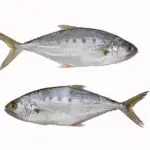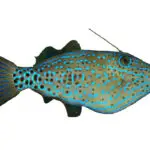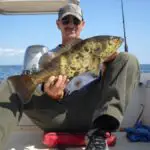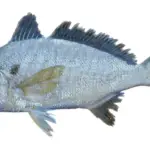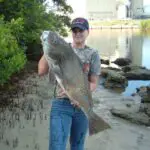Pinfish and pigfish are small saltwater fish commonly used as bait. While they can look somewhat similar at first glance, pinfish are much smaller and generally only grow to be about half the size of pigfish. Pinfish also have a dark spot behind the gills.
While they are both small bait fish that inhabit the same waters, the pinfish and the pigfish are very different fish that come from different families.
To learn more about pinfish vs pigfish, read on!
Table of Contents
- Pinfish vs Pigfish
- Pinfish Details
- Pigfish Details
- Why the Confusion?
- Which Is Better for Bait?
- Related Posts
Pinfish vs Pigfish
The pinfish is part of the Lagodon family while the pigfish is classified as an Orthopristis.
The pinfish has small sharp teeth, while the teeth of the pigfish are much flatter.
The pigfish derives its name from its ability to grind its teeth together and produce a distinct grunting sound, like that of a pig. They have an air bladder that works to strengthen this grunting sound making it very loud.

Unlike pinfish, pigfish tend to travel in large schools for protection.
Pinfish use their small pointed teeth to tear up their food, while pigfish use their flatter teeth to grind up hard shells and exoskeletons.
For this reason, pigfish are able to feed on mollusks and crustaceans more easily.
Pinfish have a more round profile, whereas pigfish tend to be more long and slender.
Pinfish Details
Pinfish rarely grow to be larger than eight inches and feature a dark circular spot behind their gills. They have a small mouth with sharp teeth, yellow fins, and blue and yellow stripes. They feed on small fish, shrimp, and crustaceans near the coastline and congregate near structure.
The average length of the pinfish is between three and six inches, with the average weight being between a quarter and half-pound.
They feature a prominent dark spot behind their gills, and they have sharp teeth as well as a very sharp spine and fins.
Pinfish tend to congregate around structure and rocks, as they require a fair amount of cover from predator fish.

They can be found all across the Gulf of Mexico and are extremely common along the United States gulf coast and both coasts of Florida.
While the pinfish habitat technically extends all the way up the East coast of the United States, they are rarely found north of the Carolinas.
Pinfish have been caught as far north as Massachusetts, and an invasive pinfish have been caught off the coast of Sicily.
Pinfish prefer water with a high salinity content and typically stick to depths of between 30 and 50 feet. They do not congregate in large schools, though they are known for associating with other pinfish in smaller groups.
Pinfish commonly eat small fish, barnacles, algae, and shrimp.
Pigfish Details
Pigfish can grow to nearly double the size of pinfish, with the maximum length being 15 inches. They are light brown with short fins and their bodies feature many small markings that are usually blue and orange in color. They make a grunting sound caused by their teeth grinding.
Pigfish are usually somewhere between 4 and 12 inches in length, with their maximum size being 15 inches.
They prefer sandy flat areas, and they do a good portion of their feeding during the nighttime.
While pinfish are spiked and pointy with sharp spines and fins, pigfish are smooth and do not pose a threat of harm to an angler using them as live bait.
For this reason, many anglers prefer to use pigfish as live bait, as they often attract the same predator fish.
Unlike pinfish, pigfish can grow to a significant enough size that some anglers choose to eat them.!

Larger pigfish can provide a significant enough amount of meat to make them worth cleaning, and the lack of sharp spines makes the job fairly quick and easy to accomplish.
See Also: Are Pinfish Good to Eat? You May Be Surprised!
Why the Confusion?
Pinfish and pigfish are both found in the same habitats and are both extremely common bait fish in coastal waters along the Gulf of Mexico and Florida. While pigfish grow to be larger, they are shaped similarly and younger pigfish are often the same size as pinfish are.
It is fairly easy for experienced anglers to spot the difference between these two common coastal baitfish, but inexperienced anglers often do not know the difference.
Many anglers use the names interchangeably and don’t bother to learn the difference between the two.
Bait and tackle shops also share some of the blame for this confusion, pigfish are often sold as “pinfish,” and vice versa…but this article proves, there is a difference!
Due to their versatility and wide availability, both of these fish get lumped together into the same category, similar to the term “minnow” with freshwater bait.
Which Is Better for Bait?
Pinfish and pigfish are both extremely common bait fish and are both often used for live bait when ocean fishing in the Gulf of Mexico and off the coast of Florida. While pinfish are well known as one of the best live bait fish around, pigfish can also work great to attract big fish, and do not have the sharp fins like a pinfish does.
One of the reasons that many anglers do not know the difference between these two extremely common baitfish is that they produce essentially the same results.
While a large pigfish can attract a larger predator fish, there is not a huge difference between the two in terms of bait use, and both pinfish and pigfish can be caught in pinfish traps.
It is a well-known fact that using live bait is the best way to attract monster fish, and both pinfish and pigfish will get the job done.
They both have about the same amount of action when put on the hook, though some anglers prefer to use pigfish as they aren’t sharp and easier to handle.
You May Also Like: The Top 10 Game Fish You Can Catch With Pinfish (W/Tips!)

Growing up in Florida, I’ve been surrounded by saltwater my entire life…and I love sharing my passion with others.
To learn more about why I started Saltwater Mecca, visit the ABOUT page.
Thank you for reading this article. Browse around & have some fun!

